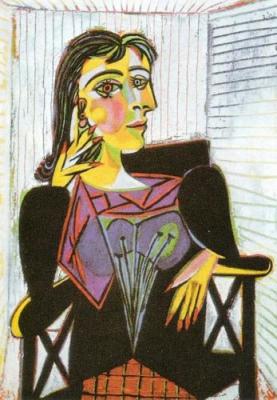Coleridge meant it about writing. I mean it about art.
I don’t want to nitpick art into bits, but I think this is an important issue. There are many who take a literal approach to art, and while that may not be fundamentally wrong, it is fundamentally juvenile and unfortunate. As a kid, I remember when my dad would sit me down for some impromptu art lessons. One time, he showed me a picture of a deformed multi-colored face (I think it was “Dora Maar”) and said “This is a Picasso.” I said “Eww” and asked “Why is Picasso’s face all mushed up?” He laughed and said “No, no. Picasso painted this face. It’s not a picture of him.” “Oh,” I said. “Then Picasso was probably a stupid artist.” I had really meant that. Didn’t he know that human faces don’t have two noses? It took a while for my dad to explain, but when I got the concept, I finally understood something fundamental about art – while my first grade classmates extolled me for drawing a good and accurate picture of a house, that was not where the artistic process ended. If anything, it only began at that point. Later, when I grasped the notion that art need not be literal, it was practically a paradigm shift.

Picasso's "Dora Maar"
Many people can draw a lifelike person. In fact, there is hardly anything “creative” about that. The creativity lies precisely in what you do with the fact that you are capable of drawing a lifelike person (now that I think about it, this actually relates a lot to my previous post). When you are unafraid to manipulate what your eye sees and what your pen produces, that’s when you really immerse yourself in the creative process. But this is all from an artist’s point of view. As a spectator (a role I admittedly assume a whole lot more often than artist), the same holds true cognitively. When you can appreciate that which is off-kilter and unconventional, that’s probably when you start to really recognize what creativity is. I’m not saying you have to like Picasso. I’m saying you have to understand Picasso. To do that, you need a “willing suspension of disbelief” which, at least from the way I see it, is essentially what a creative perspective is all about. (Of course, I shouldn’t make such sweeping statements, especially about something as ineffable as art, but I like the fact that certain concepts like Coleridge’s can be “multi-disciplinary,” and applied less exclusively than originally intended.)


Nice post. Don’t forget to categorize, though.